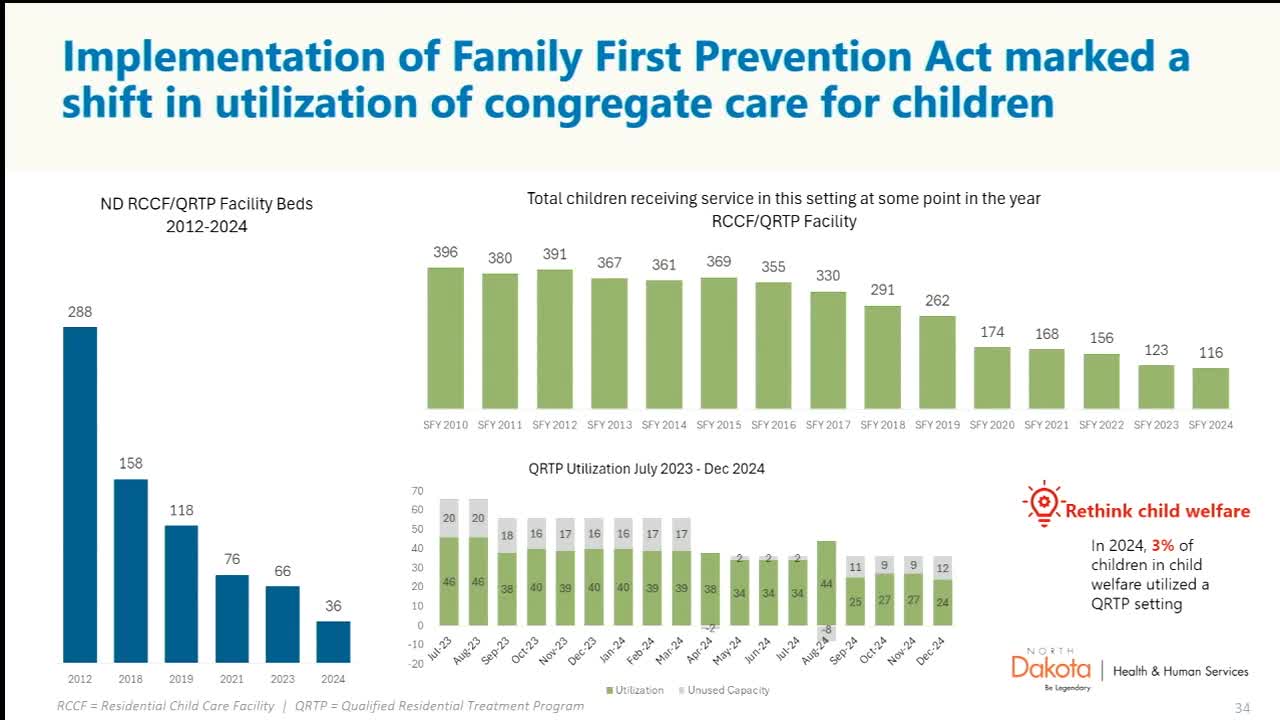North Dakota advances kinship care model for children's foster services
March 25, 2025 | Appropriations - Human Resources Division, Senate, Legislative, North Dakota
This article was created by AI summarizing key points discussed. AI makes mistakes, so for full details and context, please refer to the video of the full meeting. Please report any errors so we can fix them. Report an error »

In a recent meeting of the North Dakota Senate Appropriations Committee focused on the Human Resources Division, significant discussions emerged regarding the challenges and advancements in the state's foster care and treatment placement systems. The meeting highlighted the ongoing efforts to adapt to federal changes in reimbursement models, particularly concerning Qualified Residential Treatment Programs (QRTPs).
One of the key points raised was the operational status of a treatment facility in Fargo, which has not been functioning, contributing to a natural decline in available bed space. Legislators expressed concerns about funding challenges related to QRTPs and sought clarity on whether these issues were responsible for the drop in operational facilities. The committee emphasized the importance of stabilizing these programs to ensure they can continue to meet the needs of children requiring treatment.
Chairman Devers noted that North Dakota has been proactive in navigating these challenges compared to other states. While many states struggled with funding QRTPs, North Dakota has successfully maintained operational stability through strong partnerships and a commitment to innovative funding strategies. This approach has allowed the state to prioritize family-based care, aligning with the federal government's shift away from congregate care settings.
The meeting also addressed the increasing prevalence of kinship care, with a focus on expanding the definition of "relative" to include community members, not just blood relatives. This change aims to enhance the support network for children in foster care, allowing them to remain connected to familiar figures in their lives, such as teachers and coaches. The data presented indicated that a significant portion of children in the foster care system are under the age of seven, with a notable representation of Native American children.
Furthermore, the committee discussed the financial dynamics of Title IV-E funding, which supports foster care services. The reimbursement structure for tribal nations was highlighted, revealing that for every dollar spent on Title IV-E cases involving tribal children, the state only contributes 17 cents, with the remainder covered by federal funds. This partnership underscores the collaborative efforts between state and tribal entities to provide necessary services.
In conclusion, the discussions during the Senate Appropriations meeting underscored the complexities of the foster care system in North Dakota, particularly in light of federal policy changes and funding challenges. The committee's commitment to enhancing kinship care and maintaining operational QRTPs reflects a broader strategy to improve outcomes for children in need of support. As the state continues to navigate these issues, the focus remains on fostering stable, family-oriented environments for its youth.
One of the key points raised was the operational status of a treatment facility in Fargo, which has not been functioning, contributing to a natural decline in available bed space. Legislators expressed concerns about funding challenges related to QRTPs and sought clarity on whether these issues were responsible for the drop in operational facilities. The committee emphasized the importance of stabilizing these programs to ensure they can continue to meet the needs of children requiring treatment.
Chairman Devers noted that North Dakota has been proactive in navigating these challenges compared to other states. While many states struggled with funding QRTPs, North Dakota has successfully maintained operational stability through strong partnerships and a commitment to innovative funding strategies. This approach has allowed the state to prioritize family-based care, aligning with the federal government's shift away from congregate care settings.
The meeting also addressed the increasing prevalence of kinship care, with a focus on expanding the definition of "relative" to include community members, not just blood relatives. This change aims to enhance the support network for children in foster care, allowing them to remain connected to familiar figures in their lives, such as teachers and coaches. The data presented indicated that a significant portion of children in the foster care system are under the age of seven, with a notable representation of Native American children.
Furthermore, the committee discussed the financial dynamics of Title IV-E funding, which supports foster care services. The reimbursement structure for tribal nations was highlighted, revealing that for every dollar spent on Title IV-E cases involving tribal children, the state only contributes 17 cents, with the remainder covered by federal funds. This partnership underscores the collaborative efforts between state and tribal entities to provide necessary services.
In conclusion, the discussions during the Senate Appropriations meeting underscored the complexities of the foster care system in North Dakota, particularly in light of federal policy changes and funding challenges. The committee's commitment to enhancing kinship care and maintaining operational QRTPs reflects a broader strategy to improve outcomes for children in need of support. As the state continues to navigate these issues, the focus remains on fostering stable, family-oriented environments for its youth.
View full meeting
This article is based on a recent meeting—watch the full video and explore the complete transcript for deeper insights into the discussion.
View full meeting
